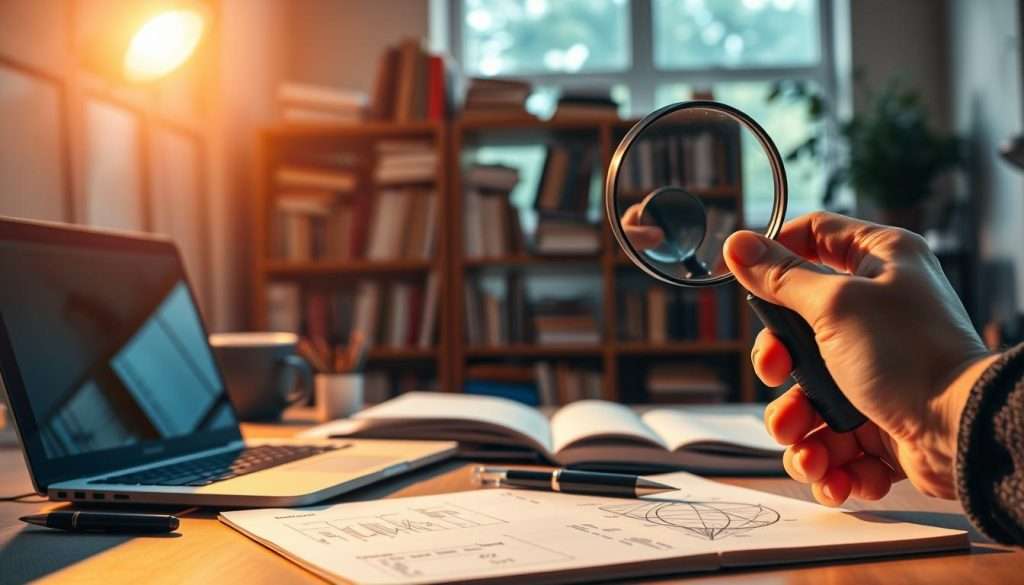Are you tired of spending hours studying without seeing the results you want? It can be really frustrating to feel like you’re wasting your time. That’s why we’re here to help you maximize your learning potential with smart study habits.
By using the right strategies, you can reach your goals without getting too tired. We think that effective learning is more than just studying a lot. It’s about studying smart. In this article, we’ll show you how to use your time wisely and reach your full potential.
Key Takeaways
- Discover the secrets to effective study habits that work for you
- Learn how to maximize your learning potential with proven strategies
- Understand the importance of working smart, not just hard
- Find out how to achieve your goals without burnout
- Unlock your full potential with the right learning techniques
The Problem with Traditional Study Methods
Spending hours studying doesn’t always mean better grades or understanding. We’ve all been stuck in a study loop, feeling like we’re not getting anywhere.
Why Spending Hours Studying Doesn’t Work
Research shows long study sessions can be bad. They lead to mental fatigue and less focus. Our brains process info in chunks, and long study times mix these chunks up.
“The more you study, the more you’ll learn” is a myth. In truth, inefficient learning techniques can lead to less learning, causing frustration and burnout.
The Diminishing Returns of Marathon Study Sessions
Long study sessions might seem good, but they often don’t pay off. As time goes on, our focus and ability to learn new things drops. This makes reaching our learning goals harder.
To reduce study time and get better results, we need to use smarter study methods. These methods should work with our brains, not against them.
The Science Behind Effective Learning
Ever wondered how your brain absorbs information like a sponge? Understanding the science behind learning can change how we study. Let’s look at how our brains process info and why some study methods work better.
How Your Brain Actually Processes Information
Our brains process info in a special way. When we learn something new, it makes connections between neurons. The more we practice, the stronger these connections get. This is called neuroplasticity, the base of learning and memory.
To use our brain’s natural processes best, we need optimal learning strategies. This includes breaking down complex info into smaller bits, called chunking. Also, using visual aids helps keep info in our memory.
The Forgetting Curve and How to Beat It
The forgetting curve shows how our memory of new info fades over time if we don’t keep practicing. To increase retention, spaced repetition is key. This means reviewing material at longer intervals to make it stick in our long-term memory.
- Review material shortly after learning it
- Return to the material after a few days
- Review again after a week, and then after a month
By using spaced repetition, we can greatly improve our memory. This makes our study sessions more effective and efficient.
Study Less, Learn More: The Core Principles
Unlocking your learning potential starts with understanding key principles. We’ll look at two main ideas: the 80/20 rule and the difference between active and passive learning.
Quality Over Quantity: The 80/20 Rule Applied to Learning
The 80/20 rule, or Pareto principle, says 80% of results come from 20% of efforts. In learning, this means a small part of your study will lead to most of your learning. To be more efficient, focus on the most important study tasks. For example, instead of reading whole chapters, focus on key concepts and practice problems.
Active vs. Passive Learning: Why It Matters
Active learning means you engage with the material, like summarizing it or making concept maps. Passive learning is just reading or listening without interacting. Studies show active learning helps you remember and understand better. Try the Feynman Technique, where you teach what you’ve learned to someone else.
| Learning Technique | Description | Benefits |
|---|---|---|
| Feynman Technique | Teach the concept to someone else | Improves understanding and retention |
| Self-testing | Test yourself on the material | Enhances recall and identifies knowledge gaps |
| Concept Mapping | Create visual maps of concepts | Facilitates connections between ideas |
Strategic Time Management for Maximum Learning
Optimizing your study schedule can help you learn more in less time. Effective time management is key to better learning and reducing study time. We’ll look at two powerful techniques to help you learn more efficiently.
The Pomodoro Technique: Study Smarter, Not Longer
The Pomodoro Technique involves focused 25-minute study sessions, followed by a 5-minute break. It keeps you focused and prevents burnout. After four cycles, take a 15-30 minute break. This method is backed by research and is an optimal learning strategy. Here’s how to use it:
- Choose a task you want to work on
- Set a timer for 25 minutes
- Work on the task without distractions during the timer period
- Take a 5-minute break
- Repeat the cycle for a total of four “Pomodoros”
- Take a longer break of 15-30 minutes
Spaced Repetition: The Key to Long-Term Retention
Spaced repetition involves reviewing material at longer intervals to solidify it in your memory. It’s great for learning new vocabulary, historical dates, or other facts. This technique can reduce study time over time. Here’s how to apply it:
| Review Session | Interval |
|---|---|
| Initial Review | 1 day |
| First Re-review | 3 days |
| Second Re-review | 1 week |
| Third Re-review | 2 weeks |

By using these techniques, you can reduce study time and improve your learning. Consistency and patience are key. With practice, you’ll become more efficient and effective in your studies.
Powerful Learning Techniques That Save Time
Learn more in less time with these top strategies. We all dream of more study hours, but quality matters more than quantity. Use efficient learning techniques to boost your results without late nights.
Retrieval Practice: Test Yourself to Learn Faster
Retrieval practice is a key method. It means recalling info from memory, not just re-reading it. This method strengthens your memory and makes info easier to recall. Use flashcards or quizzes to test your knowledge.
Interleaving: Mix Up Your Subjects for Better Results
Interleaving mixes different materials or problems. This method helps you see patterns and apply what you’ve learned. For example, mix up math problems to boost your skills.
Elaboration: Connect New Information to What You Already Know
Elaboration links new info to what you already know. This creates a network that makes new info easier to remember. Connect new info to something familiar or find a real-world use.
Dual Coding: Combine Words and Visuals for Enhanced Memory
Dual coding uses words and images to improve memory. By combining them, you encode info in multiple ways. Use diagrams and charts to enhance your notes.
Using these techniques can greatly improve your learning and help you reach your goals faster. It’s not about studying longer, but smarter.
Creating the Optimal Learning Environment
To get the most out of learning, you need the right study space. Your surroundings can either help or hurt your focus and learning.
Physical Setup: Designing Your Study Space
A good study space can really help your learning. Make sure it’s clutter-free, well-lit, and comfy. Get a comfortable chair and a spacious desk to keep you focused and avoid distractions.
Digital Environment: Managing Distractions and Focus
In today’s world, it’s key to manage digital distractions. Turn off phone and computer alerts while you study. Use website blockers to keep away from unnecessary sites. A dedicated study playlist or noise-cancelling headphones can also help you stay on track.
The Role of Sleep, Nutrition, and Exercise in Learning
A healthy body and mind are vital for learning. Make sure you get adequate sleep to keep your brain sharp. Eat a balanced diet to fuel your brain. Also, add regular exercise to boost your mood and energy.
Applying These Techniques to Different Learning Scenarios
Different learning situations need their own strategies. Whether you’re studying, working, or learning a new language, these methods can help. They make learning more effective.
Academic Learning: Mastering Coursework and Exams
Students can boost their grades with these techniques. Try the Pomodoro Technique for focused study sessions. Use spaced repetition to remember things better. For exams, practice recalling key information.
Professional Skills: Learning on the Job
Professionals can learn new skills quickly with these methods. Mix different skills to improve your flexibility. For example, use a new software on various projects. Dual coding helps you understand and remember new information better.
Language Learning: Accelerate Your Progress
Language learners can speed up their progress. Connect new words to your life or memories. Flashcards or apps can also help you remember new phrases.
| Learning Scenario | Recommended Techniques | Benefits |
|---|---|---|
| Academic Learning | Pomodoro Technique, Spaced Repetition | Improved focus, Enhanced retention |
| Professional Skills | Interleaving, Dual Coding | Better application, Improved comprehension |
| Language Learning | Elaboration, Retrieval Practice | Increased memorability, Faster recall |
Use these techniques for your specific learning needs. They can
Common Mistakes to Avoid on Your Learning Journey
Starting your learning journey can be exciting but also tricky. Many of us make mistakes that slow us down. Knowing these common errors helps you learn better and faster.
Multitasking Myths: Why It Kills Your Learning Efficiency
Multitasking might seem helpful, but it’s not good for learning. Studies show it makes us less productive and hurts our thinking skills. Trying to do too many things at once means you’re not fully focused on any one thing.
So, to learn better, focus on one thing at a time. This way, you can really understand and remember what you’re studying.

Overcoming Procrastination and Learning Resistance
Procrastination is a big problem for learners. Putting off studying until the last minute can make you stressed and do worse. To beat procrastination, break your study into smaller parts. Try the Pomodoro Technique to stay on track and avoid getting too tired.
Learning resistance is another challenge. To get past it, figure out why you’re resisting. Is the material too hard? Or are you feeling too overwhelmed? Once you know why, you can find ways to overcome it.
| Common Mistakes | Impact on Learning | Solution |
|---|---|---|
| Multitasking | Reduces productivity and impairs cognitive function | Focus on a single task at a time |
| Procrastination | Increased stress and decreased performance | Break study sessions into smaller chunks, use the Pomodoro Technique |
| Learning Resistance | Prevents effective learning | Identify underlying reasons and develop strategies to address them |
Conclusion: Your Path to Learning Mastery
We’ve looked at the best ways to maximize learning potential and reach your goals. By using the tips from this article, you can change how you learn and enhance learning outcomes. It’s time to leave behind old study habits and reach your full potential.
With hard work and the right methods, you’ll see great results. Remember, every little bit helps, and progress might be slow. But stay dedicated, and you’ll be surprised at what you can do.
Now, it’s your turn to start your journey to learning mastery. Pick one or two methods that appeal to you and see your learning improve. The path to unlocking your potential starts with choosing to learn smarter, not harder.

